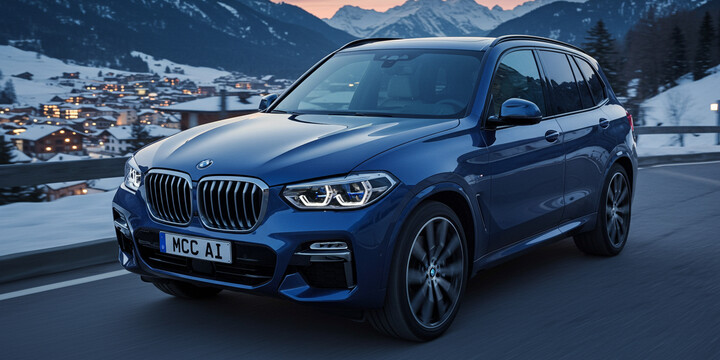
BMW X5 (2018-23)
The BMW X5 (2018-23) is a stylish and versatile luxury SUV that has established itself as a popular choice in the UK market. Renowned for its spacious interior, cutting-edge technology, and refined driving experience, the X5 combines practicality with a touch of prestige. It’s primarily used by families and professionals who need a reliable vehicle capable of handling both daily commutes and longer trips comfortably. With its commanding presence and advanced features, the BMW X5 (2018-23) stands out among rival SUVs like Audi Q7 or Land Rover Discovery, offering a blend of sporty performance and supreme comfort.
This model is especially appreciated for its high safety standards, smooth handling, and impressive build quality. Typically, it’s driven for around 10,000 miles annually, with most owners maintaining their vehicles well—typical mileage for a used BMW X5 is around 40,000 miles. The average private sale value is approximately £50,936, reflecting its premium status in the used car market. Whether you're looking for a family vehicle or a luxurious daily driver, the BMW X5 (2018-23) remains a compelling choice for those seeking performance, style, and reliability in an SUV.

average use

The latest mileage data for BMW X5s (2018-23) shows that most vehicles are relatively low to mid-mileage, with the highest proportions in the 10,000 to 50,000 miles range (approximately 34%). Notably, a significant 12.7% of vehicles have recorded under 10,000 miles, which suggests some low-mileage examples are available. Conversely, only a small percentage (around 2%) have very high mileages exceeding 100,000 miles, specifically in the 110,000 to 120,000 and above 200,000 miles categories. This indicates that while most BMW X5s tend to be maintained within lower to moderate mileages, a few do reach very high mileages, which could be of interest to buyers seeking longevity or deemed as high-mileage vehicles.

vehicle values

The dataset presents private sale price valuations for BMW X5 models (2018-23), expressed as percentage differences from an unspecified baseline. Most of these valuations are very close to zero, typically ranging from 0.3% to 6.3%, indicating that the private sale prices generally align closely with the expected market values. Notably, a few price ranges, such as "38000 to 39000," "41000 to 42000," and "33000 to 34000," show slightly higher deviations up to 6.3%, suggesting a possible premium or premium variation at these price points. Conversely, several high-mileage or higher-price ranges, like "81000 to 82000" and "74000 to 75000," have minimal deviations (~0.3%), implying stable valuations even at the upper end of mileage. Overall, the data indicates consistent valuation patterns across different price brackets, with no extreme over or underpricing evident in private sales of these BMW X5s.

production years

The data on BMW X5 vehicles (2018-2023) shows that the majority of these models were manufactured in 2019, accounting for 36.5% of the sample. Notably, vehicles from 2020 and 2022 also make up significant proportions at 18.3% and 21.2%, respectively. Conversely, the smallest share, just 2.6%, is from 2018, indicating fewer early models in the dataset. Additionally, only a modest 3.4% come from 2023, suggesting newer models are less common in this sample, possibly due to recent release dates. Overall, the distribution emphasizes that 2019 is the most prevalent year of manufacture for these vehicles.

colour popularity

The data indicates that among BMW X5 vehicles produced between 2018 and 2023, the most common main paint colours are black (42.1%) and grey (22%), together accounting for nearly two-thirds of the sample. White and blue are also popular, representing 17.2% and 18.3% respectively. Less common colours include purple and green, each at just 0.3%. The prominence of black suggests it is the most preferred or perhaps most standard colour choice for this model during this period.

ownership cycle

The data on registered keepers for the BMW X5 (2018-23) indicates that nearly 24% of these vehicles have had just one owner, suggesting a significant portion of the fleet are relatively new or well-maintained primary ownerships. About 34% have had two keepers, while a notable 22% have had three. Multiple-keeper vehicles (four or more) are less common, collectively accounting for around 20%, with 4 keepers being the most frequent among these at 10.8%. The small percentages with higher numbers of keepers (5 or more) suggest that most owners tend to retain the vehicle for a moderate period before changing, with very few cars cycling through many owners. Overall, the data suggests a healthy mix of relatively low to moderate owner change rates within this model range.

engine choices

The data for BMW X5 (2018-23) vehicles indicates that the majority are equipped with a 2.9-liter engine, accounting for 70.4% of the sample. There is also a significant portion with 3.8-liter engines (20.6%), and a smaller segment with approximately 3.0-liter engines (9%). In terms of fuel types, nearly half of the vehicles (47.1%) run on diesel, while a notable 23.3% are hybrid electric or diesel & electric models, reflecting a trend towards electrified powertrains. Petrol-powered models are less common, representing 13.2%. This data suggests that diesel variants dominate, but there is a growing adoption of hybrid powertrains among BMW X5 owners.












